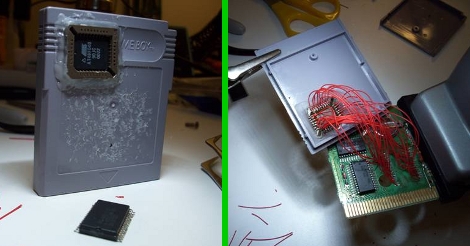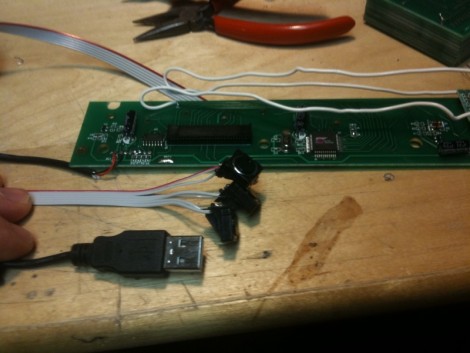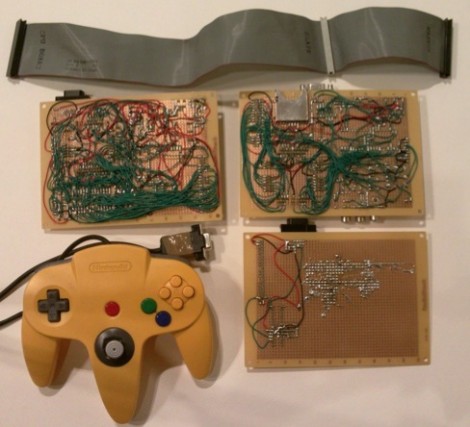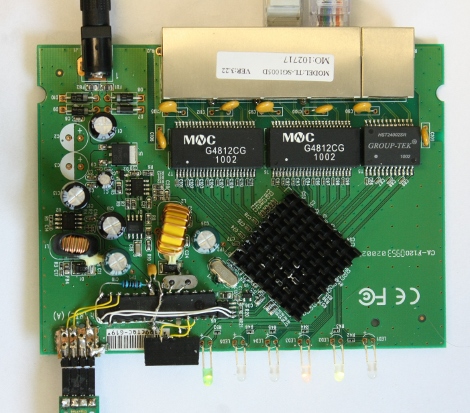[Sprite_TM] outgrew the features of the cheap unmanaged TL-SG1005D switch he was using on his home network. Instead of buying a new and much more costly switch he cracked the cheap one open and found that the RTL8366SB chip inside possessed the ability to work harder but was crippled for sale as a low-end model. It wasn’t as easy as that oscilloscope firmware upgrade we saw a while back. He had to add an AVR ATmega88 to send I2C commands to the switch. Turns out that the I2C protocol wasn’t standard and after much head scratching he found some Linux drivers for the chipset that gave him enough info to send the configuration commands he needed. Now he’s go the managed switch he needed for his VLAN for the cost of a microcontroller and some wire.
Day: May 26, 2010
PLCC Replaces Game Boy Cartridge ROM

[Gerry] sent us pictures and a few details on replacing the Game Boy cartridge chip with a flash chip. For the prototype he used a PLCC and a little wire porn to interface a flash chip with the cartridge’s PCB while still having access to it for programming. In retrospect he plans to use a 32-pin ZIF socket on the next version to make things easier. It does work and he’s had some success loading his own code and getting it to run. There are other cartridge hacks that let you load code onto a cartridge but if you have the knowhow and the parts this makes for a fun weekend project. We’ve posted the rest of the photos that [Gerry] sent us after the break.
Update: Gerry is working on a video and a pinout. We’ll post info once we get a hold of it.
One-armed Coding Using A Half-qwerty Hack

[Matthew Daughtrey] is going to have one of his paws out of service for a while following some hand surgery. Making a living as a coder seems a bit harder with one hand but he was able to find some solutions online only to balk at price tags reaching $600. He came up with a way have similar functionality on a standard keyboard with creative key mapping and a few auxiliary buttons.
The product he’s trying to mimic is the half-qwerty keyboard produced by Matias Corporation. It sounds crazy, but you can easily use your right hand to type all of the letters the left hand normally would just by mirroring the key locations. That big gray thing you store in your mellon and frequency put at risk handles this automatically. You should give the demo a try. We found that we’re quite good at it and only get confused when switching between the two halves of the keyboard.
But we digress. [Matthew] wrote a script that will mirror all the key mappings when he holds down the Windows key. He then hacked a second keyboard to extend momentary push sensors as seen above. He plans to use them with a partially mobile thumb after the surgery, or to build a foot pedal (we say build the pedal). An elegant hack that is a pittance compared to the official hardware.
Sound Card Driven Servo Motor
[youtube=http://www.youtube.com/watch?v=1LG2Ecsk13Q]
[Darrell] is using a sound card to drive this servo motor. The motor draws power from a cellphone battery with the control signal coming from one of the audio channels. It’s not too surprising that this works since the motor just needs a PWM signal to operate and that’s what is used to create the different frequencies of sound on electronic speakers. We’re not sure what [Darrell’s] got planned for this system but he mentions that two servos can be used, one on each audio channel. If you’re not using your sound card this would be a way to stop using the Arduino for that mail checker and just use a little flag attached to a servo. When mail comes in the appropriately engineered sound raises the flag.
32-bit ARM7 Gaming rig

Are you hardcore enough to build your own 32-bit ARM powered gaming console AND use point-to-point soldering to accomplish this? [Craig Bishop] did just that when building his GameSphere console project. First thing’s first, click through the jump and watch the game play video. He wrote that game in the C language in less than a day which in itself is quite remarkable. On the hardware side of things he’s got an interesting mix; an Ateml AT91R40008 chip drives this system with PIC 18F4682 for VGA signal generation and a PIC 18F2685 to interface with the N64 controller. We like what he’s done so far and would love to see this end up in its own game cabinet. Continue reading “32-bit ARM7 Gaming rig”
The Story Of Mr. Stabby
[youtube=http://www.youtube.com/watch?v=XHvXPOSaNbg]
Mr. Stabby was once a broken down bum, sitting on the curb, waiting for an eternity in the city dump. Luckily, someone found him and brought him to the NYC Resistor hacker group. They promptly performed some modifications and brought him back to life.
He’s now a happy go lucky stab-bot with a twinkle in his eye and a skip in his step. His repitoir includes gouging, slashing, and of course stabbing. He can be controlled via a cell phone and has a nifty voice interface.
The video above is from when Mr. Stabby was runner up at the tech crunch hackday.
Bay Area Maker Faire 2010 Video
[youtube=http://www.youtube.com/watch?v=lliJ1vLoAoU]
Since the previously-posted stills can’t quite convey the chaos of last weekend’s Maker Faire, here’s some video from the event to help get you through hump day. It’s like three liters of Jolt Cola in a two liter bottle.
One thing even video can’t adequately capture is our gratitude toward our readers at the show who took time to express their appreciation for the blog. You guys and gals rock our world. Thank you!












